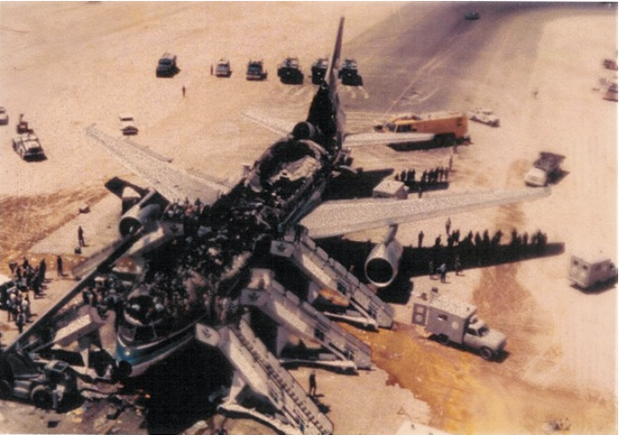All passengers and crew perished in the deadliest aviation accident in history due to the failure to evacuate promptly.
On the evening of January 2nd, flight JAL516 operated by Japan Airlines collided with a commuter plane on the runway of Haneda Airport (Tokyo). The collision immediately caused the aircraft to erupt in a fierce fire and explosion, shattering on the runway.
Five out of the six individuals on the small police aircraft of the Japanese Coast Guard were killed. However, all 379 people, including passengers and crew members aboard the Japan Airlines flight, were rapidly evacuated in time, with only 14 people sustaining injuries after the accident.
The incident quickly raised an alarm about the importance of emergency evacuation procedures when an aircraft faces trouble. Specifically, how the professionalism and swift reactions of both the pilot and the crew played a crucial role in those life-or-death moments.
The miraculous survival of the 379 people on the flight is a real-life miracle since in many other cases, passengers aren’t as fortunate. The Saudi Arabian Airlines (Saudia) Flight 163 in 1980 is a prime example.
The Most Horrific Aviation Disaster
Saudia Flight 163 (SV163/SVA163) was a scheduled passenger flight of Saudia from Riyadh International Airport (now Riyadh Air Base), Saudi Arabia, to King Abdulaziz International Airport in Jeddah, Saudi Arabia. This was the deadliest accident involving a Lockheed L-1011 TriStar aircraft and the deadliest in the Middle East country.
Flight 163 took off from Qu’aid-e-Azam International Airport (now Jinnah International Airport) in Karachi, Pakistan, at 18:32 Pakistan time, headed to Jeddah, Saudi Arabia, with a scheduled stopover at Riyadh Airport. It arrived in Riyadh at 19:06 local time and had to stop for two hours to refuel before taking off at 21:08 to Jeddah.
Saudia Aircraft Ignited After Landing
After nearly 7 minutes of flight, the crew received a warning about smoke from the cargo compartment. They took the following 4 minutes to attempt confirming the warnings, after which the Flight Engineer went to the cabin to verify the presence of smoke. Captain al-Khowyter decided to return to the airport, and First Officer Hasanain announced their intention over the radio at 21:20. At 21:25, Engine No. 2 (the center engine) stalled due to fire from the operating cables. Subsequently, at 21:29, the engine ceased during the final check.
At 21:35, Captain al-Khowyter declared an emergency and landed back at Riyadh. After landing, the aircraft continued to taxi for 2 minutes and 40 seconds. Airport firefighting equipment was arranged, and rescue personnel were present.
While the crashed aircraft had successfully landed, luck was not on their side. When the aircraft came to a stop, the crew reported they were shutting down and preparing to evacuate. However, when ground personnel approached the aircraft, they observed that two wing-mounted engines were still running, thus making it impossible to open the doors.
Eventually, they ceased operating 3 minutes and 15 seconds after the aircraft stopped, and ground personnel lost contact with the crew. At this point, no external fire was visible, but flames were observed through the windows at the rear of the aircraft. 23 minutes after engine shutdown, ground personnel finally managed to break open the aircraft door. Three minutes later, the inside of the aircraft was engulfed in a fierce fire. All 379 individuals inside had perished.
Why Didn’t the Captain Order Evacuation?
The biggest question regarding this tragedy remains why Captain al-Khowyter did not evacuate the aircraft in time. Clearly, if the evacuation procedure involving opening the aircraft door and getting passengers out had been executed correctly, many lives could have been saved.
Reports from Saudi indicate that the crew couldn’t open the Plug-door type (a door designed to seal automatically by utilizing pressure differential and often used on pressurized cabin aircraft). Perhaps passengers and flight attendants inside either couldn’t move due to smoke inhalation or were hesitant to open doors on a moving aircraft. The aircraft was believed to be still pressurized during landing due to the standby pressurization system in the cabin, and both outflow valves were nearly closed. The outflow valves should have been fully opened upon landing to equalize the pressure for the aircraft.
Upon entering the gutted aircraft, the crew was found still seated in their positions, and all victims were found in the forward half of the aircraft. Post-mortem examinations revealed that all perished due to smoke inhalation, not burns. This indicates they may have died before the door was opened.
However, this remains speculative, and if passengers and the crew were still alive when the aircraft successfully landed, a critical error in failing to evacuate could have led to the deaths of nearly 400 people.
The investigation revealed the fire started in the C3 cargo compartment and spread to extensively damage the cabin floor. Amidst the wreckage, two butane stoves were found, but there was no evidence indicating they caused the fire; thus, the source of the fire remains undetermined.

Many believe that if an evacuation had been carried out promptly, the tragedy might have been averted.
Although the inflight fire in Flight 163 was an extremely serious emergency, it’s evident that the high death toll resulted from the crew’s mistake. Investigators calculated that if the pilots had stopped the aircraft as quickly as possible and ordered an immediate evacuation, it’s highly probable that everyone would have survived, much like the incident with the Japanese flight on January 2nd.












